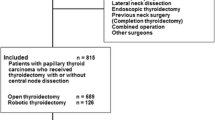Abstract
Introduction
The aim of this study, from a surgical, oncological, and functional perspective, was to identify whether bilateral axillo-breast approach robotic total thyroidectomy (RTT) for differentiated thyroid cancer (DTC) has different surgical outcomes compared to open total thyroidectomy (OTT).
Methods
Initially, 796 patients who underwent total thyroidectomy were primarily reviewed and 178 who were ineligible for analysis were excluded. Propensity score matching analysis adjusted for clinicopathological characteristics (sex, age, body mass index, extent of central node dissection, tumor size, extrathyroidal extension, and thyroiditis) was conducted, with 246 patients in the OTT group matched with 123 patients in the RTT group.
Results
There were no significant differences in surgical outcomes in terms of surgical safety and oncological safety between the OTT and RTT groups, except in mean operation times (123.51 ± 32.63 vs. 198.39 ± 37.93 min, respectively; P < 0.001). However, the median parathyroid and laryngeal function recovery times were shorter in the RTT group than in the OTT group [88 ± 33.09 (95% CI: 23.148–152.852) vs. 100 ± 16.20 (95% CI: 68.242–131.768) days; P = 0.044 and 87 ± 32.40 (95% CI: 23.489–150.511) vs. 118 ± 49.50 (95% CI: 20.985–215.015) days; P = 0.002].
Conclusions
The recovery times of laryngeal and parathyroid function were significantly shorter in RTT patients than in OTT patients for DTC. To verify a definitive conclusion about the superiority of robotic total thyroidectomy in terms of parathyroid and laryngeal function recovery, further studies may be necessary.





Similar content being viewed by others
References
Giddings A (1998) The history of thyroidectomy. J R Soc Med 91:3–6
Linos D (2011) Minimally invasive thyroidectomy: a comprehensive appraisal of existing techniques. Surgery 150:17–24
Bellantone R, Lombardi CP, Raffaelli M et al (1999) Minimally invasive, totally gasless video-assisted thyroid lobectomy. Am J Surg 177:342–343
Koo DH, Kim DM, Choi JY et al (2015) In-depth survey of scarring and distress in patients undergoing bilateral axillo-breast approach robotic thyroidectomy or conventional open thyroidectomy. Surg Laparosc Endosc Percutan Tech 25:436–439
Murphy D, Challacombe B, Khan M et al (2006) Robotic technology in urology. Postgrad Med J 82:743–747
Lee KE, Koo DH, S-j Kim et al (2010) Outcomes of 109 patients with papillary thyroid carcinoma who underwent robotic total thyroidectomy with central node dissection via the bilateral axillo-breast approach. Surgery 148:1207–1213
Kang S-W, Jeong JJ, Yun J-S et al (2009) Robot-assisted endoscopic surgery for thyroid cancer: experience with the first 100 patients. Surg Endosc 23:2399
Lang BHH, Wong CK, Tsang JS et al (2015) A systematic review and meta-analysis evaluating completeness and outcomes of robotic thyroidectomy. Laryngoscope 125:509–518
Lee J, Nah KY, Kim RM et al (2010) Differences in postoperative outcomes, function, and cosmesis: open versus robotic thyroidectomy. Surg Endosc 24:3186–3194
Tae K, Kim KY, Yun BR et al (2012) Functional voice and swallowing outcomes after robotic thyroidectomy by a gasless unilateral axillo-breast approach: comparison with open thyroidectomy. Surg Endosc 26:1871–1877
Lee KE, Choi JY, Youn YK (2011) Bilateral axillo-breast approach robotic thyroidectomy. Surg Laparosc Endosc Percutan Tech 21:230–236
Haugen BR, Alexander EK, Bible KC et al (2016) 2015 American Thyroid Association management guidelines for adult patients with thyroid nodules and differentiated thyroid cancer: the American Thyroid Association guidelines task force on thyroid nodules and differentiated thyroid cancer. Thyroid 26:1–133
Tuttle RM, Tala H, Shah J et al (2010) Estimating risk of recurrence in differentiated thyroid cancer after total thyroidectomy and radioactive iodine remnant ablation: using response to therapy variables to modify the initial risk estimates predicted by the new American Thyroid Association staging system. Thyroid 20:1341–1349
Yi KH (2016) The revised 2016 Korean Thyroid Association guidelines for thyroid nodules and cancers: differences from the 2015 American Thyroid Association guidelines. Endocrinol Metab 31:373–378
Perrier ND, Randolph GW, Inabnet WB et al (2010) Robotic thyroidectomy: a framework for new technology assessment and safe implementation. Thyroid 20:1327–1332
Stukel TA, Fisher ES, Wennberg DE et al (2007) Analysis of observational studies in the presence of treatment selection bias: effects of invasive cardiac management on AMI survival using propensity score and instrumental variable methods. JAMA 297:278–285
Inabnet WB III (2012) Robotic thyroidectomy: must we drive a luxury sedan to arrive at our destination safely? Thyroid 22:988–990
Lanfranco AR, Castellanos AE, Desai JP et al (2004) Robotic surgery: a current perspective. Ann Surg 239:14
Lee KE, Rao J, Youn Y-K (2009) Endoscopic thyroidectomy with the da Vinci robot system using the bilateral axillary breast approach (BABA) technique: our initial experience. Surg Laparosc Endosc Percutan Tech 19:e71–e75
Lee KE, Koo DH, Im HJ et al (2011) Surgical completeness of bilateral axillo-breast approach robotic thyroidectomy: comparison with conventional open thyroidectomy after propensity score matching. Surgery 150:1266–1274
Kim BS, Kang KH, Kang H et al (2014) Central neck dissection using a bilateral axillo-breast approach for robotic thyroidectomy: comparison with conventional open procedure after propensity score matching. Surg Laparosc Endosco Percutan Tech 24:67–72
Chai YJ, Suh H, Woo J-W et al (2017) Surgical safety and oncological completeness of robotic thyroidectomy for thyroid carcinoma larger than 2 cm. Surg Endosc 31:1235–1240
Seup Kim B, Kang KH, Park SJ (2015) Robotic modified radical neck dissection by bilateral axillary breast approach for papillary thyroid carcinoma with lateral neck metastasis. Head Neck 37:37–45
Büttner M, Musholt TJ, Singer S (2017) Quality of life in patients with hypoparathyroidism receiving standard treatment: a systematic review. Endocrine 58:14–20
Smith E, Verdolini K, Gray S et al (1996) Effect of voice disorders on quality of life. J Med Speech Lang Pathol 4:223–244
Gonçalves Filho J, Kowalski LP (2004) Postoperative complications of thyroidectomy for differentiated thyroid carcinoma. Am J Otolaryngol 25:225–230
Thomusch O, Machens A, Sekulla C et al (2000) Multivariate analysis of risk factors for postoperative complications in benign goiter surgery: prospective multicenter study in Germany. World J Surg 24:1335–1341. https://doi.org/10.1007/s002680010221
Kwak HY, Kim HY, Lee HY et al (2015) Robotic thyroidectomy using bilateral axillo-breast approach: comparison of surgical results with open conventional thyroidectomy. J Surg Oncol 111:141–145
Lang BH-H, Wong CK, Tsang JS et al (2014) A systematic review and meta-analysis comparing surgically-related complications between robotic-assisted thyroidectomy and conventional open thyroidectomy. Ann Surg Oncol 21:850–861
Ficarra V, Novara G, Rosen RC et al (2012) Systematic review and meta-analysis of studies reporting urinary continence recovery after robot-assisted radical prostatectomy. European Urol 62:405–417
Steurer M, Passler C, Denk DM et al (2002) Advantages of recurrent laryngeal nerve identification in thyroidectomy and parathyroidectomy and the importance of preoperative and postoperative laryngoscopic examination in more than 1000 nerves at risk. Laryngoscope 112:124–133
Hernandez J, Bann S, Munz Y et al (2004) Qualitative and quantitative analysis of the learning curve of a simulated surgical task on the da Vinci system. Surg Endosc 18:372–378
Bae DS, Koo DH, Choi JY et al (2014) Current status of robotic thyroid surgery in South Korea: a web-based survey. World J Surg 38:2632–2639. https://doi.org/10.1007/s00268-014-2606-z
Author information
Authors and Affiliations
Corresponding author
Ethics declarations
Conflict of interest
Dr. Dong Sik Bae and Do Hoon Koo have no conflicts of interest or financial ties to disclose.
Rights and permissions
About this article
Cite this article
Bae, D.S., Koo, D.H. A Propensity Score-matched Comparison Study of Surgical Outcomes in Patients with Differentiated Thyroid Cancer After Robotic Versus Open Total Thyroidectomy. World J Surg 43, 540–551 (2019). https://doi.org/10.1007/s00268-018-4802-8
Published:
Issue Date:
DOI: https://doi.org/10.1007/s00268-018-4802-8




